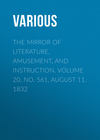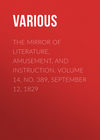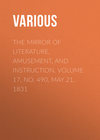Czytaj książkę: «The Journal of Negro History, Volume 6, 1921», strona 17
The book begins with a rather long introduction, discussing the geography, history, and institutions of Africa. Much space is here given to spiritual beliefs as a stimulus to the development of music. Then follows a discussion of song-poems and of the early music to which they were set. The actual contents begin with a treatment of songs, tales, and proverbs of the Ndau tribe by C. Kamba Simango. The reader, if he has found the details of the contents mentioned above a little tiresome, will have his interest quickened again by the explanation of the Song of the Rain Ceremony, the Spirit-Song, the Love-Song, the Dance of Girls, Children's Songs, Laboring-Songs, Mocking-Songs, and the like. There are also such folk-tales as the Hare and the Tortoise, the Baboon, How the Animals dug their Well, the Jackal and the Rooster, Death of the Hare, the Legend and Song of the Daughter and the Slave, and the Sky-Maiden.
After this portion of the book comes the Songs and Tales of the Zulu Tribe, recorded from the singing and sayings of Madikane Cele, a Zulu of royal blood. This includes such as the Song of War, Song of Children, Dance Songs, Love Songs very much like those mentioned above. It treats also of such folk-tales as the Creation Story. The music to which these song poems have been set, doubtless will interest most the student of music. Along with this appear keys to the pronunciation of the dialects and translations of some of the songs.
The book is well printed and well illustrated with the art work of the Africans portraying in different ways another phase of African life.
Educational Adaptations. By Thomas Jesse Jones. Phelps-Stokes Fund, New York, 1919. Pp. 92.
This work presents valuable history in its introduction, which consists largely of a sketch of the life of the founder of the Phelps-Stokes Fund, Caroline Phelps Stokes. It is interesting to note that she was a descendant of English Puritan ancestors, eminent for their ability and Christian character. They early manifested interest in the relief of the poor and in the enlightenment of the heathen in foreign parts. From them, therefore, came much of the assistance given to promote the Sunday School movement, Bible and tract societies, missionary organization, the colonization enterprise, and the abolition of slavery. With this record before her it is not surprising, therefore, that Miss Caroline Phelps Stokes early united with the church with a desire "to live the years that still remained with a fixed and determined purpose to do her duty to God, regardless of how disagreeable that duty might be."
Measuring up to this ideal Miss Stokes became interested in the Negro race. She visited the South to inspect the schools for the education of the Negro and impressed with their needs she thereafter lavished upon them gifts which had a direct bearing upon the development of education among these people. Among these were donations to the Haines Industrial School, Hampton, and Tuskegee. Manifesting interest also in the local problems of the race, she undertook to secure better housing for the poor whites and blacks in New York City and established the Phelps-Stokes Fund for the improvement of tenement house dwelling in New York City for the poor families of New York City and for educational purposes in the enlightenment of Negroes, both in Africa and the United States North American Indians and deserving white students.
There follows then a brief account of how the provisions of this will have been carried out. Next one finds set forth a plan for educational-co-operation and the scope of the work of the committee on education which finally brought out the two-volume report of Dr. Thomas Jesse Jones, the Educational Director of the fund. This is followed by a brief statement on Negro education in the United States, which is a resumé of Dr. Jones's report. The more interesting part of this volume is that which sets forth in detail the manner in which this fund is being used by co-operation with the educational and religious agencies in the South, by giving fellowships to students in Southern universities to stimulate research into Negro life and history, by assisting the work of the University Race Commission on Race Questions, and that of the Southern Publicity Committee.
The Negro Faces America. By Herbert J. Seligmann, formerly Member of the Editorial Staffs of the New York Evening Post and the New Republic. New York and London, Harper and Brothers, 1920. Pp. iv., 319. Price, $1.75 net.
"There is, in fact, no race problem in the United States." A sociological study which within its first four pages makes this assertion must gain the reader's attention and interest at the start. That there is no solution to the race problem is a statement heard so often in America that it has become almost proverbial; that the solution is simple if our citizens would approach the problem fairly is an observation made less often; but that there is no problem would seem to be either the flippant remark of one who dabbles in sociology or the profound utterance of a new seer.
Mr. Seligmann, nevertheless, does not hesitate either to make this assertion or to attempt to demonstrate its truth. In "the conversational tone of the scientist," he cites the testimony of anthropologists, the opinions of students of racial and sociological questions, the conclusions reached by scientific surveys of rural and urban conditions, the observations of sworn eye-witnesses and the findings of grand juries in cases of inter-racial disturbance. The conclusion to be reached, to his mind, is that the so-called race problem is not a problem in itself, but a "blind spot" in the eye of the American public, a "color psychosis," a "habit of thought" by which questions of race and racial differences are connected, "frequently deliberately," with phases of American life with which they should have nothing to do,—in fact, with every phase of American life. This habit of thought, Mr. Seligmann says, is prevalent throughout the southern part of this country and is spreading through the North and West. In the cities, it makes the smallest and most natural examples of race tension "definitely subject to manipulation by political leaders and their allies in newspaper offices," raises the rent to Negro applicants for houses, protests against their living in certain localities, opposes the Negro in industry as he awakens to the strategic position which he occupies and uses such opposition in the fostering of race riots. In the rural communities of some parts of the South, it has created an "American Congo" in which peonage is practiced openly. In the World War, it made the United States' "essential struggle" internal rather than external, brought about the rebirth of the Ku-Klux Klan on this side of the waters, and worked against the success of the Nation's arms abroad. In social questions it makes sex "the distorted glass by which the Negro is presented to view." It "lays its fetters upon science" and stifles the truths of anthropology with a blanket of myth. The spread of the habit of thought is in many cases part of a deliberate propaganda, the chief agent of which is the American newspaper, and "the only course for white Americans to pursue is to cultivate thorough-going skepticism as to everything which American newspapers publish about the Negro."
Such are the conditions. Meanwhile, Mr. Seligmann continues, a "new Negro" has been rising. His growth was not started by the War, as some think, but accelerated by it, for it was inevitable that he should come into being. He ranges, in type, from the radical editors of The Messenger to the "new bourgeoisie" which has learned to fight back and die, if need be, for the sake of principle and justice. This is the type of Negro who, in spite of differences of opinion within the race itself, is gradually working his way toward leadership; and this is the Negro who now "faces America." "Newly emancipated from reliance upon any white savior, [he] stands ready to make his unique contribution to what may some time become American civilization."
What is to be his future? It is Mr. Seligmann's opinion and conclusion that his future lies largely with the forces of labor, among whom "color and the habits of thought which come from emphasizing color distinctions must be subordinated to the need for joint consideration of common difficulties." "It depends largely," too, "upon the emancipation of the American people from their newspapers" and upon whether or not they will demand and obtain "systematic information on matters concerning colored people and their relation to white people"; for a knowledge of the truth will set the nation free from the "color psychosis" under which it now labors.
That such a book as this should have been written is in itself an indication, let us hope, of the coming of the new day in racial relations toward which Mr. Seligmann points the way.
D. A. Lane, Jr.
NOTES
Houghton Mifflin & Company has published John Drinkwater's Lincoln, the World Emancipator. This is not a biography of Lincoln but rather a type representing the ideals of the American nation and at the same time the bonds which have attached the people of the United States to those of England.
In the Magazine of History for November-December 1917, there appeared an important letter of Abraham Lincoln to the Mayor of New York bearing upon a proposed celebration of the Union victories in the West during the Civil War.
The article entitled "Fifty Years of Negro Citizenship," by Dr. C. G. Woodson which appeared in the last number of The Journal of Negro History, is now being used as supplementary reading by the Senior Class of the Law School of Howard University. This article has been reprinted.
In the January number of The American Historical Review appeared a number of documents entitled: "General M. C. Meigs on the conduct of the Civil War." In that same number is an interesting article entitled: "A Confederate Diplomat at the Court of Napoleon III," by L. M. Sears.
The Associated Publishers, a firm recently organized to publish books bearing on the Negro will soon bring out Dr. C. G. Woodson's work on The Negro Church. This is an intensive treatise of the development of religion among the American Negroes. The leading topics discussed are: The Attitude of the Early Missionaries toward the Negro, the Dawn of the New Day, Pioneer Negro Preachers, The Independent Church Movement, The Growth of the Negro Church, The Situation in the South before the Civil War, Preachers of Versatile Genius in the North, The Civil War and the Church, Religious Education, The Call of Politics, The Statistics of the Negro Church and The Negro Church Socialized.
This same firm in the near future will publish also Dr. Woodson's long delayed text book to be entitled The Negro in Our History. Because of the many upheavals in the publishing world, it has been impossible to bring out this work at an earlier date but this firm promises the publication of it by next fall.
The Journal of Negro History
Vol. VI—July, 1921—No. 3
THE MATERIAL CULTURE OF ANCIENT NIGERIA
The opinion of the Western World toward Africa and Africans is in the process of a very slow, yet very tremendous, change. The distant yet ultimate development of this process will bring about a most important revolution in the world of modern thought. It will be marked by a complete reversal of the prevailing present-day evaluation of the history of a continent and of the accomplishments and possibilities of a great people.
To the lay mind of the modern world, Africa is a gigantic jungle of barbarians, bamboo and baboons, where Livingstone traveled, Rhodes prospected, and Roosevelt hunted. Furthermore, it is only within the last twenty-five years or more that even that learned group whose profession is the exposition and interpretation of human history has begun to modify its opinions in this connection.
An insight into the spirit of learned opinion regarding Africa and the Africans only a comparatively short time ago may be gained from the following article, which appeared in a Berlin journal in 1891.337 The article, in part, runs:
"With regard to its Negro population, Africa in contemporary opinion offers no historical enigma which calls for a solution, because from all the information supplied by our explorers and ethnologists, the history of civilization proper in the continent begins, as far as concerns its inhabitants, only with the Mohammedan invasion.
"Before the introduction of a genuine faith and a higher standard of culture by the Arabs, the nations had neither political organization nor, strictly speaking, any religion, nor any industrial development. None but the most primitive instincts determine the lives and conduct of the Negroes who lack every kind of ethical inspiration. Every judicial observer and critic of alleged African culture must once for all make up his mind to renounce the charm of poetry and wizardry of fairy lore, all those things which in other parts of the world remind us of a past fertile in legend and song; that is to say, must bid farewell to the attractions offered by the Beyond of History, by the hope of eventually realizing the tangible impalpable realm conjured up in the distance which time has veiled within its mists, and by the expectation of ultimately wresting some relics of antiquity every now and again from the lap of the earth.
"If the soil of Africa is turned up today by the colonist's plough share, no ancient weapon will lie in the furrow; if the virgin soil be cut by a canal, its excavation will reveal no ancient tomb; and if the ax effects a clearing in the primeval forest, it will nowhere ring upon the foundations of an old world palace. Africa is poorer in record history than can be imagined. 'Black Africa' is a continent which has no mystery, nor history!"
But now this view of Black Africa and its peoples so widespread and well established a generation ago is being slowly dissipated and a new and revolutionary view of the mysterious contents is building itself in its stead. The facts and forces bringing about this great change fall into three main classes; they are of an historical, archaeological and ethnological character.
The real beginning of this change of opinion may be said to date from the capture of the old African city of Benin by the British military forces in the year 1897. The economic and political aspects of the incident do not concern us here, but from an anthropological point of view it proved to be one of the most important incidents of the nineteenth century. For as Ling Roth,338 the noted traveler and ethnologist, has said, "the taking of Benin City opened up to us the knowledge of the existence of hitherto unknown African craft, the productions of which will hold their own among some of the best specimens of antiquity of modern times."
Many of these objects of art were carried away from Benin by the members of the invading expedition to Europe, where they created a profound impression and astounding surprise in scientific circles throughout the continent. C. H. Read, in a paper before the Anthropological Institute of Great Britain and Ireland, on the "Art of Benin City," the year following their discovery, says: "It need scarcely be said that at the first sight of these remarkable works of art we were at once astounded at such an unexpected find."339
Just about this time, and continuing down to the present day, a number of Oriental scholars began to bring out modern language translations of the works of numerous Arab writers bearing upon African history—chief among them being the works of El Bekri, Ibn Batuta and Ibn Khaldoun. The most important, however, at least from one angle, was a translation of the Tarikh es Sudan, or The History of the Sudan, which is not the work of an Arab at all, but the joint work of several Sudanese blacks. In its original form it was written both in Arabic and in the Songhay languages. The book was translated into French by M. Houdas, the eminent French professor of the Oriental School of Languages of Paris.
"The book," says Lugard,340 "is a wonderful document, the narrative of which deals mainly with the modern history of the Songhay Empire, relating the rise of this black civilization there in the fifteenth and sixteenth centuries and its decadence up to the middle of the seventeenth century.... But it is not merely an authentic narrative. It is for the unconscious light which it sheds upon the life, manners, politics and literature of the country that it is valuable. Above all, it possesses the crowning quality displayed usually in creative poetry alone, of presenting a vivid mind picture of the character of the men with whom it deals. It has been called the 'Epic of the Sudan.' It lacks the charm of form, but in all else the description is well merited. Its pages are a treasure house of information for the careful student, and the volume may be read many times without extracting from it more than a small part of all that it contains."
Barth, who obtained some fragments of an Arabic copy when he was on his way to Timbuctoo, goes so far as to say that the book forms "one of the most important additions that the present age has made to the history of mankind."341 Like the unknown culture which the Benin bronzes revealed, the translation of these documents brought to the attention of the learned and academic circles of the Western World, in a more available form, surprising accounts of the sometime existence of powerful and age-old kingdoms and empires in the heart of Black Africa, which hitherto had scarcely been suspected.
Following close upon this was the cursory but illuminating report of Une mission archeologique au Sudan francais, headed by the soldier-ethnologist, Lieutenant Louis Desplaynes. The report, Le Plateau Central Nigirien, Paris, 1907, brought to Europe much valuable information bearing upon the past cultures of the practically unknown Nigerian plateau regions.
Passing over a few very important ethnological studies bearing for the most part upon present-day cultures, we come last of all to what is in the truest sense of the word the wonderful and astounding revelations regarding the pre-historic culture of an ancient Negro race on the West Coast of Africa. These revelations were brought to light as the result of the publications by Leo Frobenius of his Der Afrika Sprach in Berlin in 1913.342 This was a popular account of the experiences and findings of the German Inner African Exploration Expedition during its travels in the Nigerian area for the years 1910-1912. As important as are the ethnological and archaeological finds of this expedition, which will be considered further on, one of its most significant features was its bold advocacy and support of an idea which has been hesitantly advanced in a few circles ever since the study of the Benin bronzes and the Nubian monuments, namely, the existence of a genuinely superior type of culture in Central Africa in pre-classical and pre-Christian times.
Such, then, by way of introduction is the nature of the sources from which comes the influence which is slowly and haltingly, yet surely, bringing about the change in current opinion regarding "Black Africa" as is evidenced by the timely but hitherto unsuccessful effort of Harvard University to treat the records of the African peoples scientifically in keeping with the standard set in the first volume of the Varia Africana. This paper, however, as may be inferred from its title, does not undertake to survey the facts covering the whole field, but restricts itself to materials of a more or less archaeological character, that is, to the architecture, tombs and the arts and crafts of a small section of this ancient land.
There are two reasons for approaching this whole subject in this way. First, the materials and facts herewith considered are in the main of a tangible and undisputed character; and, secondly, it is the study of architecture and the arts and crafts of this particular locality that has been the premier force in changing the old opinion of the world towards Africa. Let us then turn now for a somewhat detailed study of these materials.
As has been said in the introduction, it was the revelation incident to the taking of Benin by the British that marks the real beginning of a serious and scientific interest in the past cultures of Central Africa. The incident started a movement of both a forward and a backward reach. On the one hand, it led to subsequent searchings which ultimately resulted in the finding of additional evidences of culture in that territory, as well as to a reconsideration of the value of the reports of the travelers and adventurers on the West Coast from the fifteenth century on.343 The combined result has been the bringing to light of objects and evidences of achievement which place the ancient and medieval African on a plane with, and in many cases above, his contemporaries in Europe and America.
The reports of earlier adventurers and travelers in the Benin territory previous to the British conquest gave us pictures of towns and buildings which, all things considered, are of no mean order, and which reflect the existence of a social and cultural development of a very long standing. The earliest recorded description of Benin City, according to Ling Roth,344 is that of an old Dutch chronicler who wrote as "D. R." and whose works first appeared in Germany in 1604. His description is as follows:
"At first the town seems very large; when one enters it one comes at once into a broad street which appears to be seven or eight times broader than the Warme street in Amsterdam; this extends straight out, and when one has walked a quarter of an hour along it, he still does not see the end of the street.... At the gate at which one enters there is a very high bulwark, very thick and strongly made, with a very deep, broad ditch, but it was dry and full of high trees. This ditch extends a good way, but we do not know whether it extends around the town or not. That gate is a well-made gate, made of wood, to be shut according to their methods, and watch is always kept there. Outside this gate there is a large suburb.... One sees a great many lanes and streets on both sides, which also extend far and straight, but one can not see the end of them on account of their great extent.
"The houses in this town stand in good order, one close to the other, like houses in Holland. Houses in which well-to-do people, such as gentlemen, dwell, have two or three steps to go up, and in front have an ante-court where one may sit, which court or gallery is cleaned every morning by their servants, and straw mats spread for sitting on. Their rooms or apartments with (the court) are four square, having a roof all round, which, however, does not join in the middle, but is left open, so that the wind, rain and daylight may enter. In these houses they live and eat, but they have specially built little houses for cooking, as well as other huts and rooms.... The king's court is very large, being many square places within, surrounded by courts wherein watch is always kept. This king's court is so large that the end is not to be seen, and when one thinks he has come to the end, one sees through a gateway other places or courts, and one sees many, many stables."
Another description of Benin which seems to corroborate this former description, and which was itself substantiated by later and more recent reports, appeared in a book345 published by one Dapper, a Dutchman, in Amsterdam in 1668. It seems that Dapper himself was never at Benin, but received most of his information about the country from the writings of a Sam Blomert, who, Dapper says, lived for many years in Africa.346 As Ling Roth points out, subsequent reports and the recent finds seem to bear out the truth of his account.
According to Dapper,
"the town comprising the queen's court is about five or six [Dutch] miles in circumference, or, leaving out the court, three miles inside the gates. It is protected at one side by a wall ten feet high, made of double stockades of big trees tied to each other by cross beams, fastened crosswise and stuffed up with red clay solidly put together.... The town possesses several gates, eight or nine feet in height, and five feet in width, with doors made of a single piece of timber hanging, or turning on a peg like the peasants' fences here in this country. [Holland.]
"The king's court is square and stands at the right-hand side as one enters the town by the gate of Gotton, and is certainly as large as the town of Harlem, and entirely surrounded by a special wall like that which encircles the town. It is divided into many magnificent palaces, houses and apartments for courtiers and comprises beautiful long and square galleries about as large as the Exchange at Amsterdam, but one larger than another, resting on wooden pillars from top to bottom, covered with cast copper on which are engraved the pictures of their war exploits and battles, and are kept very clean. Most palaces and houses are covered with palm leaves instead of square pieces of wood [shingles], and every roof is decorated with a small turret, ending in a small point on which birds are standing, these birds being cast in copper, and having outspread wings cleverly made after living models.
"The town has thirty very straight and broad streets, each of them about one hundred and twenty feet wide or about as wide as the Heeren or Keezersgracht [canals] at Amsterdam from one row of houses to the other, from which branch out many side streets, also broad, but less so than the main streets.
"The houses are built alongside the street in good order, the one close to the other as here in this country [Holland], adorned with gables and steps and roofs made of palm or banana leaves, or leaves from other trees; they are not higher than a 'stadie,' but usually broad with long galleries inside, especially so in the case of the houses of the nobility, and divided into many rooms, which are separated by walls made of red clay, very well erected, and they can make and keep them as shiny and smooth by washing and rubbing as any wall in Holland can be made with chalk, and they are like mirrors. The upper storys are made of the same sort of clay; moreover, every house is provided with a well for a supply of fresh water."
Before going any further with this description, it may be well to state that the description of the nature and character of the finish of the walls given here is substantiated by accounts of travelers in these parts as late as the end of the nineteenth century. Captain Boisragon, one of the two survivors of the ill-fated white expedition to Benin in 1897, in comparing the houses of Benin with those of another nearby city, says that "the chief of Gwatto's house was very much superior; the walls, which were very thick, being polished till they were nearly as smooth and shiny as glass."347 Mr. Cyrl Punch, who traveled in Yorubaland in the eighties of the nineteenth century, gives us a hint of the widespread practice of this sort of wall polishing even so late as forty-five years ago, and furnishes us with a very interesting account of how the polished effect was produced. "For giving a high polish to the clay walls in Yorubaland," says Punch, "the leaves of the Moringa pterygosperinia are mashed up and rubbed over the clay." Of a certain house in the town Brohemi he continues to say that "the walls were better polished than any in Benin. They were like marble."348
In comparing the earlier descriptions of Benin and other African cities in this general area with the descriptions of later writers, an important fact stands out, namely, that these cities had already reached their highest point of development before the coming of the white man; for in a description of Benin by another Dutchman, Nyendall, which appeared in 1704, we read the following: "Formerly the buildings in this village were very thick and very close together, and in a manner it was over-populated, which is yet visible from the ruins of the half remaining houses; but at present the houses stand like poor men's corn, widely apart from each other." His description otherwise is very similar to those previously given, yet his account does bring out an additional point which is worthy of note, namely, the reason for the use of clay in building. "The houses are large and handsome," he writes, "with clay walls; for there is not a stone in the whole country as large as a man's fist."349 In the same connection, Legraing, who visited Benin in 1787, also hints at the reason for the extensive use of clay and wood as the principal structural materials. Around Benin, according to this observer, "the vestiges of an old earthen wall are still to be seen; the wall could hardly have been built of any other material, as we did not see a single stone in the whole journey up."350
The recent reports by Leo Frobenius on his findings further up into the interior, aside from giving us a picture of present-day conditions of cities which he believes to date back to pre-classical and pre-Christian times, also show the absence or scarcity of durable producing materials. But, most important of all, the report indicates the grandeur of African cities in ancient times. In discussing the buildings in the present-day city of Ilife, which he believes was the capital or center of an ancient African theocracy, he says: "There can be no doubt that the entire plan and style of architecture gives the city of Ilife a pleasantly dignified character. If, however, I am to summarize all the life and activities of this city of palms and divinities, I cannot, indeed, speak of anything great and sublime, because that lies buried too deep beneath the soil and debris of centuries, yet I can say that it has a dreamy respectability."




















